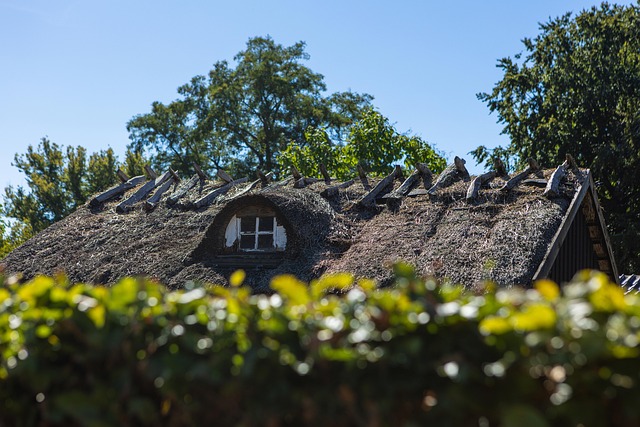Lightweight synthetic roofs are an eco-friendly, durable, and versatile solution for both residential and commercial applications. Made from sustainable materials like recycled plastic or plant-based composites, these roofs offer excellent durability, reduce structural load on buildings, provide superior insulation, and require low maintenance. Their flexibility allows installation over various substrates, making them cost-effective for renovations. With increasing demand for sustainable building practices, lightweight synthetic roofs are gaining popularity as a green alternative, contributing to reduced carbon footprints and improved energy efficiency in diverse climates. Case studies demonstrate their successful integration in urban projects and educational institutions, showcasing both environmental benefits and aesthetic value.
Discover the future of roofing with eco-friendly, lightweight synthetic roofs. This comprehensive guide explores the benefits and diverse applications of these innovative materials, from reducing environmental impact to enhancing energy efficiency. We delve into popular green roofing options, practical installation tips, and inspiring case studies showcasing successful implementations. Embrace the green revolution and transform your space with a sustainable, lightweight synthetic roof.
- Understanding Lightweight Synthetic Roofs: Benefits and Applications
- Popular Eco-Friendly Materials for Sustainable Roofing
- Installation and Maintenance: Tips for a Green Roof Revolution
- Case Studies: Successful Implementations of Lightweight Eco-Roofs
Understanding Lightweight Synthetic Roofs: Benefits and Applications
Lightweight synthetic roofs are an innovative solution that offers a range of benefits for both residential and commercial applications. One of their key advantages is their environmental friendliness, as they are made from sustainable materials while still providing excellent durability. These roofs are designed to be lighter than traditional options, reducing the structural load on buildings, which is particularly beneficial for older structures or those in seismic zones.
The versatility of lightweight synthetic roofs is another significant advantage. They can be installed over various substrates, including existing shingles or metal decking, making them an efficient and cost-effective choice for renovations. Moreover, these roofs offer superior insulation properties, contributing to energy efficiency and reduced carbon footprints. Their low maintenance requirements and resistance to fading, cracking, and peeling further enhance their appeal, ensuring a long-lasting and visually appealing finish.
Popular Eco-Friendly Materials for Sustainable Roofing
In the pursuit of sustainable building practices, eco-friendly materials for roofing have gained significant traction. Among the popular choices are those that offer both environmental benefits and durability, such as lightweight synthetic roofs. These innovative solutions are crafted from recycled content or renewable resources, reducing their carbon footprint compared to traditional asphalt shingles.
Lightweight synthetic roofs, for instance, are made from materials like recycled plastic, rubber, or plant-based composites. They excel in water resistance, impact resilience, and fire safety, making them a versatile option for various climates. Moreover, their lightweight nature reduces the structural load on buildings, leading to cost savings in construction and improved energy efficiency.
Installation and Maintenance: Tips for a Green Roof Revolution
The shift towards eco-friendly roofing solutions is gaining momentum, and one of the most promising areas is the installation of green or lightweight synthetic roofs. These innovative systems offer a sustainable alternative to traditional materials, contributing to a more environmentally conscious future. When considering a green roof revolution, proper installation and ongoing maintenance are key.
To ensure success, start by choosing a high-quality, durable synthetic roofing material designed for eco-friendly applications. Lightweight synthetic roofs are particularly ideal as they can be easily installed on various structures, reducing the need for extensive structural modifications. Regular cleaning and inspection are essential maintenance practices to keep the roof performing optimally. Remove any debris or vegetation buildup, especially in drains and gutters, to prevent water damage and ensure proper drainage. A well-maintained green roof not only extends its lifespan but also enhances its environmental benefits, making it a valuable asset for any property.
Case Studies: Successful Implementations of Lightweight Eco-Roofs
In recent years, numerous case studies have showcased the successful implementation of lightweight eco-roofs, proving their environmental benefits and aesthetic appeal. These innovative systems offer a sustainable alternative to traditional roofing, with many urban projects embracing their use due to their ability to reduce carbon footprints significantly. For instance, several high-rise buildings in major cities have adopted lightweight synthetic roofs, which not only minimize the structural load but also incorporate green spaces, enhancing insulation and air quality.
One notable example is the implementation of a living roof system in a dense urban center. By installing a deep-soiling layer with native vegetation, this project achieved remarkable results in terms of heat reduction and biodiversity promotion. Similarly, schools and community centers have adopted lightweight synthetic roofs, providing students and residents with outdoor learning and recreation spaces while contributing to local ecosystems. These case studies highlight the versatility and effectiveness of eco-friendly roofing solutions in various settings.
Lightweight synthetic roofs are not only an innovative solution for modern architecture but also a sustainable choice that contributes to our planet’s well-being. By utilizing eco-friendly materials and proper installation techniques, as highlighted in this article, we can create green spaces while reducing environmental impact. As more people embrace the benefits of these roofs, we move closer to a greener future, ensuring a healthier and more vibrant landscape for generations to come.
